Newstead Abbey - Ancestral Home of the Byrons
by Steve Orme
Set back at the end of a sweeping mile-long drive that opens out into 320 acres of parkland, the exterior of Newstead Abbey doesn't look particularly inviting. But inside one can glimpse a fascinating insight into the life of George Gordon Byron, the sixth Lord -- better known as Byron the romantic poet, described by his mistress Lady Caroline Lamb as "mad, bad and dangerous to know".
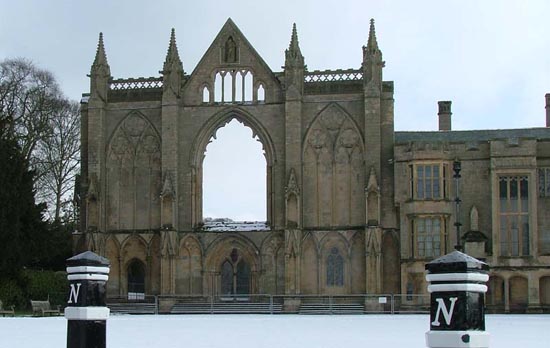
Many people who visit Newstead nowadays are eager to learn more about the poet with the racy reputation who was probably Britain's first celebrity. He was, after all, the man who claimed to have bedded 200 women and was rumoured to have had an incestuous relationship with his half-sister Augusta Leigh, and who displayed many of the characteristics which classified his ancestors as eccentrics.
Yet many Newstead visitors leave with a totally different impression of Byron. They read his works and revelatory letters, and come to look upon him as a genius who had an immense influence on poetry, music, opera and the arts generally. He was reviled and revered in equal measure -- castigated for his loose morals yet respected for standing up to the establishment and rebelling against injustice and oppression.
But there is far more to Newstead than the home of a Romantic poet. Other occupants of the house included the poet's predecessor, the "wicked" Lord Byron who squandered a personal fortune; Thomas Wildman, who fought in the Battle of Waterloo; and big game hunter William Frederick Webb, a great friend of the famous missionary Dr David Livingstone.
The Past
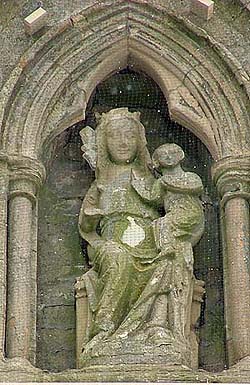 Newstead Abbey was originally a monastic house, founded by Henry II between 1164 and 1174 in memory of his grandfather. It remained a monastery for almost 400 years. Newstead Abbey was originally a monastic house, founded by Henry II between 1164 and 1174 in memory of his grandfather. It remained a monastery for almost 400 years.
A community of ordained priests devoted themselves to worship, study and meditation. They were known as the Black Canons because they wore black cassocks with white surplices and hooded black cloaks.
Evidence of the canons' way of life is rife at Newstead. The remnants of doorways that led into the church can be seen in the cloister, along with the canons' lavatorium or washing place and a recess in a wall where students stored their books.
The nearby chapel was once the Chapter House in which the canons met to hear a chapter of the Monastic Rule and to discuss the day's business. Next door the Becket and Plantagenet Rooms, now separated by a 19th century wall, used to form the site of the calefactory or warming room -- the only place apart from the kitchen and the infirmary where there would have been a fire in the winter months.
The present-day entrance hall was used for offices and storage while the prior entertained visitors to Newstead in the room above it. Next to the guest hall was the prior's parlour -- the present dining room -- where the prior would conduct meetings with merchants. Hidden behind a door in the panelling is what is left of a toilet which the prior would have used.
There is very little remaining from the refectory where the canons ate in silence while one of them read aloud from a Bible. A small section of a wall decoration survives from about 1200.
The Byron Family
In 1534 King Henry VIII declared himself the head of the Church in England and over the next few years completed the dissolution of all the monasteries. He granted Sir John Byron of Colwick "all the house and site, ground and soil, of the late Monastery or Priory of Newstede". The cost: £810.
Sir John moved in and converted the old priory into his home. He dismantled most of the church and re-used the stone. Apart from that, he kept most of the original structure.
When he died in 1567 he was succeeded by his son, known as "Little Sir John with the Great Beard". He was exceptionally extravagant and kept troupes of actors and musicians who were paid to entertain guests on special occasions. Later the Byron family was active in the Civil War. The fifth Sir John, who became the first Lord Byron, was raised to the peerage for his services to the King.
Despite strenuous efforts by some members of the family to look after their magnificent home, others were far more intent on having a riotous time. None was more rebellious than the fifth and "wicked" Lord Byron. He married Elizabeth Shaw in 1747 when he was 25 and subsequently frittered away her £70,000 fortune on improvements to Newstead, works of art and travel.
Many people have since praised him for enlarging the Upper Lake -- but he used it for mock naval battles with a miniature fleet of ships with their own crew. He also erected a building known as Folly Castle, now demolished, on a hill overlooking the lake which was said to have been used for orgies.
The Poet
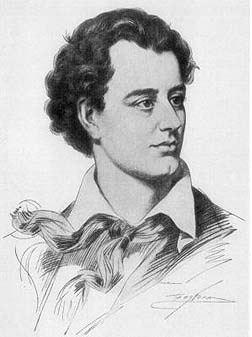 Born in 1788, George Gordon Byron inherited the Newstead estate at the age of ten, when he became sixth Baron Byron of Rochdale. But he didn't move in immediately, waiting until shortly before his 21st birthday to take up residence. He found Newstead just as the previous occupant, his great-uncle, had left it -- needing major repairs and stripped of its contents which had been sold off because of mounting debts. Born in 1788, George Gordon Byron inherited the Newstead estate at the age of ten, when he became sixth Baron Byron of Rochdale. But he didn't move in immediately, waiting until shortly before his 21st birthday to take up residence. He found Newstead just as the previous occupant, his great-uncle, had left it -- needing major repairs and stripped of its contents which had been sold off because of mounting debts.
The sixth Lord wasn't particularly wealthy and furnished only some of the smaller rooms in which he made himself comfortable. One guest noted it was easy to forget that "one was domiciled in the wing of an extensive ruin".
The two largest rooms, the Great Hall and the Great Dining Room, had been emptied before Byron was born. He couldn't see the point of spending money he hadn't got to restore them, so he used them for sporting purposes. He and his former university friends practised boxing, fencing and pistol shooting in the two rooms.
The poet lived at Newstead for only six years until 1814, when he moved to Italy. Financial problems meant he had to sell the estate but finding a buyer proved difficult. Byron eventually sold Newstead to Thomas Wildman in about 1817, ending nearly four centuries of the Byron family's owning the house.
Today Newstead has much to impress the Byron scholar. His bedroom contains the bed Byron transported to Newstead from his rooms at Trinity College, Cambridge. You can see the table at which he wrote some of his poetry. There's also a selection of his letters which are reasonably easy to decipher -- if you read all of them it'll take you a good couple of hours
Later Owners
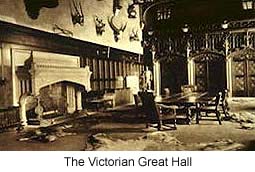 Byron sold Newstead to his boyhood friend Thomas Wildman (1787-1859) for the vast sum of £94,500. Wildman came into a fortune from plantations in Jamaica owned by his family. From 1817 onwards Wildman spent another £100,000 restoring the house and reclaiming the gardens. He bought fine tapestries, ancient armour and furniture in the medieval style. He decorated the rooms with stained glass. He painted plaster walls and ceilings to look like richly carved oak and stone. Byron sold Newstead to his boyhood friend Thomas Wildman (1787-1859) for the vast sum of £94,500. Wildman came into a fortune from plantations in Jamaica owned by his family. From 1817 onwards Wildman spent another £100,000 restoring the house and reclaiming the gardens. He bought fine tapestries, ancient armour and furniture in the medieval style. He decorated the rooms with stained glass. He painted plaster walls and ceilings to look like richly carved oak and stone.
Wildman is recognised as the man who preserved Byron's home -- although his improvements made the building much different from how it was in the poet's day. Wildman entertained many people who wanted to honour Byron's memory, including the composer Franz Liszt.
On Wildman's death his widow was forced to sell and the new owner was William Frederick Webb (1829-1899), a landowner who was keen to stamp his own mark on the property. He loved new inventions and installed gas lighting and central heating. Trophies from his African hunting expeditions gave the house an exotic look and he even placed the head of a rhinoceros over the mantelpiece in the Great Hall. One of the visitors at this time was Dr Livingstone, who had saved Webb's life when the pair of them were in Africa.
After Webb's death the estate was passed to each of his four surviving children and then to his grandson Charles Ian Fraser. He sold it to the Nottinghamshire philanthropist Sir Julien Cahn who presented it to Nottingham Corporation in 1931.
Newstead Today
Like many other significant buildings and monuments in the UK, Newstead Abbey needs a vast amount of money spending on it to reverse the damage done by weather, pollution and a lack of care. However, Nottingham City Council, which has two other Grade 1 listed buildings to look after, can't protect Newstead without help.
Over the past seven years the West Front of the priory which dates from the 13th century has been on English Heritage's Register of Buildings at Risk. Now the city council has instigated an adopt-a-stone appeal, allowing individuals and organisations to preserve in particular the carvings of birds, animals, foliage and a statute of the Virgin Mary.
Newstead, though, is more than a country house. The estate boasts 28 acres of formal gardens, with the Great Garden particularly impressive. It's thought to have been created no later than 1720 and consists of a series of broad terraces, sloping lawns and a water feature, the Eagle Pond, at its centre.
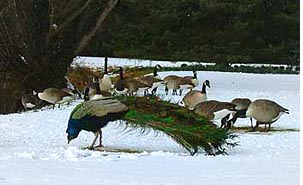 The poet Byron's monument to his favourite dog, Boatswain, who died of rabies in 1808, is located near the Eagle Pond. Ducks and a peacock wander around near the house and don't bother visitors, except when they approach with morsels of food. The poet Byron's monument to his favourite dog, Boatswain, who died of rabies in 1808, is located near the Eagle Pond. Ducks and a peacock wander around near the house and don't bother visitors, except when they approach with morsels of food.
The other gardens date mainly from the 19th century and were mostly the work of the Webb family. They even commissioned a Japanese landscape architect to lay out the Japanese Garden in 1907. Many of the stone ornaments and original plants were brought from Japan. The garden is recognised as one of the finest examples of its type in Britain.
Newstead has also had to bow to the pressure of commercialism and runs a programme of events throughout the year to supplement its income. As many as 200 couples a year decide for themselves whether Newstead encapsulates the romanticism for which Byron was noted by getting married in a civil ceremony in the Orangery, originally the south transept of the priory. A small number also tie the knot in Newstead's chapel -- but naturally they have to live in the parish or have ties with the area.
Other attractions include antique and craft fairs; torchlit and nature walks around the grounds; ghost tours of the house; open-air theatre on summer evenings; and Christmas celebrations. Between November and Christmas, when the house is closed to the public, thousands of schoolchildren learn what it was like to live at Newstead in Victorian times.
Even if you have little interest in the Byronic experience, Newstead Abbey has something to keep people of all ages occupied for several hours whatever the weather.
Getting there
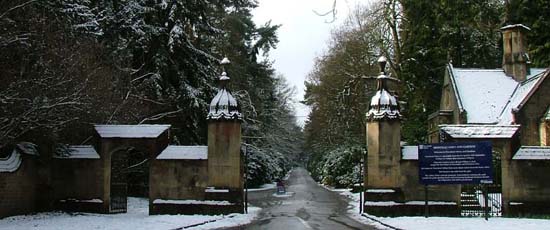
The gates of Newstead Abbey are 12 miles north of Nottingham on the A60 and five miles south of Mansfield. Leave the M1 motorway at junction 27 and follow the signs to Sherwood Forest before picking up the brown signs for the Abbey.
Buses run from Nottingham city centre to the Abbey gates while the Sherwood Forester goes right into the grounds on Sundays.
Byron's "Epitaph to a Dog"
Following is a portion of Byron's "Epitaph to a Dog," inscribed upon Boatswain's monument at Newstead Abbey. Read the complete poem at http://readytogoebooks.com/LB-dog63.htm.
NEAR this spot
Are deposited the Remains
of one
Who possessed Beauty
Without Vanity,
Strength without Insolence,
Courage without Ferocity,
And all the Virtues of Man
Without his Vices.
This Praise, which would be unmeaning flattery
If inscribed over Human Ashes,
Is but a just tribute to the Memory of
"Boatswain," a Dog
Who was born at Newfoundland,
May, 1803,
And died at Newstead Abbey
Nov. 18, 1808.
More Information:
We regret that we no longer have the resources to maintain up-to-date links and/or hours and pricing details for the various sites and attractions listed on this website. For more information about the location(s) listed above, please use your favorite search engine or visit Wikipedia.
Steve Orme has been a freelance journalist and broadcaster for more than 20 years, writing for newspapers, magazines, radio and BBC Television. He specialises in travel, theatre and basketball. He lives with his wife Sue in Derbyshire and at weekends can often be found walking in the county's beautiful countryside -- usually behind the person with the map!
Article and photos © 2005 Steve Orme
Lord Byron image courtesy of Wikipedia.com
Great Hall photo courtesy of Nottingham City Council.
| 